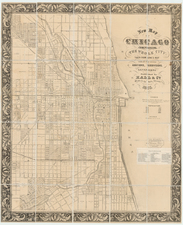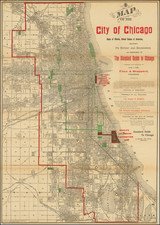Map of rail lines in central and southern Chicago, with Belt Railway lines highlighted red. Also noted trackage rights, team tracks, and Chicago Switching District limits. Streets with numbering marked in margins. E to Hammond Ind, S to 127th, W to Mannheim Rd, N to Irving Park Blvd.
Railroads Information on Belt Railway services and services in lower margin.
The Belt Railway of Chicago
The Belt Railway of Chicago is the city's oldest belt line, formed by the Chicago & Western Indiana. The C&WI's history begins on June 6, 1879 when it was chartered by John B. Brown and a few business partners. With an ever-increasing number of railroads reaching the Windy City they realized a terminal line would be of great benefit. In less than a year the C&WI had connected Dolton and an interchange with the Chicago & Eastern Illinois (22 miles). This gave it connections with the Illinois Central; Michigan Central; Santa Fe; Wabash; Pittsburgh, Fort Wayne & Chicago (a Pennsylvania Railroad subsidiary); St. Charles Air Line; and the Chicago, Rock Island & Pacific (Rock Island). During January of 1882 the C&WI continued expanding by acquiring the Chicago & Western Indiana Belt Railway and South Chicago & Western Indiana pushing its western reach to Hammond, Indiana just across the state line. Along the way additional interchange commenced with the Chicago, Milwaukee & St. Paul Railway (an early Milwaukee Road predecessor), Nickel Plate Road, Monon, Erie, and again with the Santa Fe and Wabash.
While the Chicago & Western Indiana was just getting under way John Brown recognized a true belt line would be beneficial to serve the numerous railroads entering Chicago. Unlike the C&WI, which provided access to only a limited number, the new operation would, in theory, serve everyone. This would eliminate the need of these larger systems to build separate rights-of-way into the city.
The Belt Railway of Chicago's history begins in early 1881 when Brown chartered what was then known as the Belt Division, Chicago & Western Indiana Railroad. Construction began later that year and proceeded quickly; to the east the road partially utilized trackage rights over the C&WI before turning west through Forest Hill and Hayford. The route then swung northward to Cicero with intentions of reaching the Chicago & North Western and Chicago, Milwaukee & St. Paul at Cragin Junction in Jefferson, Illinois. Here, a serious disagreement ensued with the community concerning a crossing right-of-way.
During a time in which railroads sometimes took the law into their own hands, tracks were ultimately built over the crossing without permission. After carrying out this rogue operation the company successfully received an injunction to prohibit their removal. As a result, the Belt Division was deemed complete by August of 1883. While the project was under construction the consortium which controlled the C&WI also took over (via lease) the Belt Division in October of 1882. It was subsequently renamed the Belt Railway Company of Chicago and then proceeded to build its own line into South Chicago, which ended the need to operate over the C&WI.











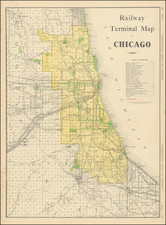
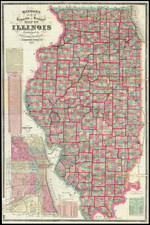
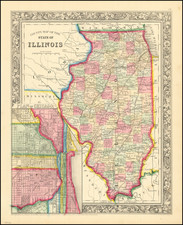
![The City of St. Louis [with] The City of Chicago](https://storage.googleapis.com/raremaps/img/small/76144.jpg)
